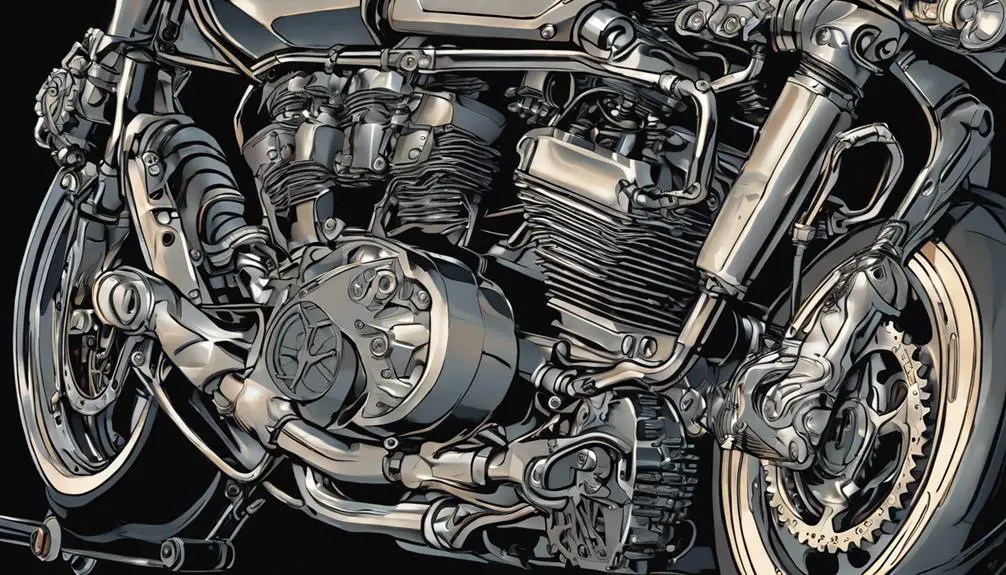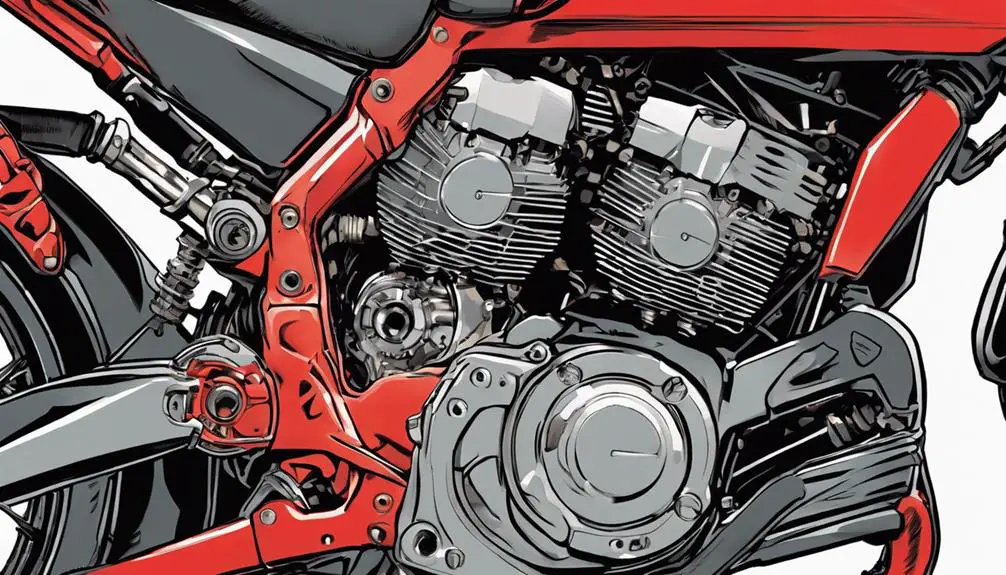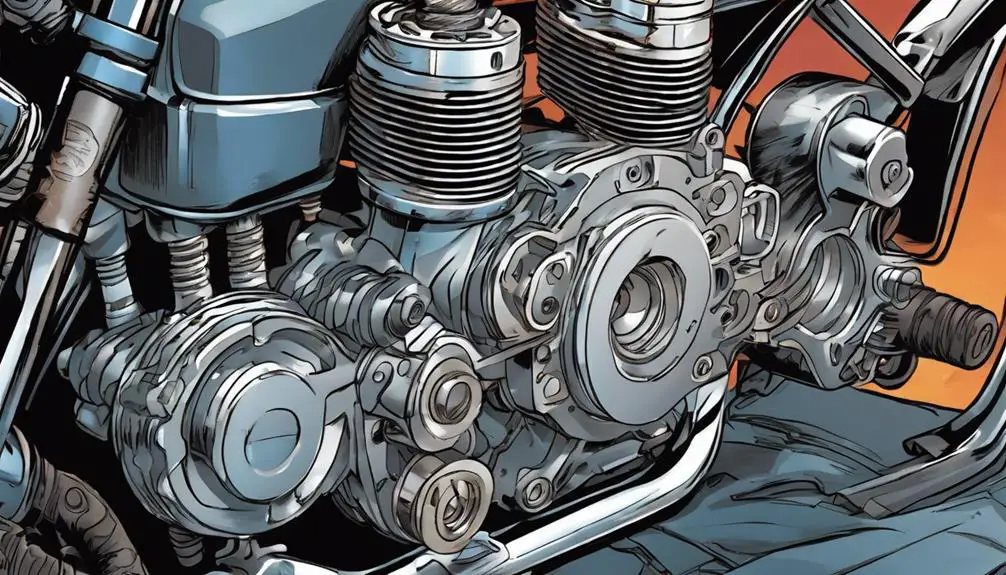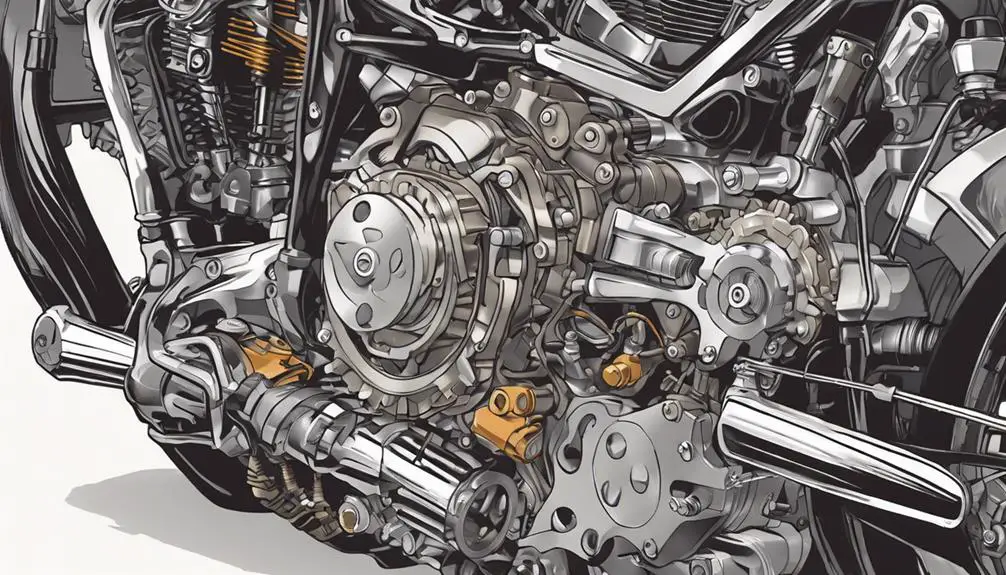You know, it's funny how just a slight adjustment in your motorcycle's valve timing can make a world of difference, especially if you're riding a Ducati. Understanding the essential specs not only enhances your bike's performance but also fine-tunes your riding experience. From the ideal degrees of intake to exhaust timings, there's a lot to unpack. Just when you think you've mastered the basics, you might discover common pitfalls that could be holding you back. Wouldn't you want to guarantee you're getting the most out of your machine?
Key Takeaways
- Ducati engines typically have intake valve timing ranging from 30° to 40° BTDC and 5° to 10° ATDC.
- Exhaust valve timings for Ducati engines range from 40° to 50° BTDC and 10° to 20° ATDC.
- Adjusting valve timing can enhance low-end torque or boost high-end power depending on riding needs.
- Proper valve timing is crucial for maximizing engine performance, efficiency, and throttle response.
Overview of Ducati Engines

Ducati engines are renowned for their performance and innovative designs, making them a favorite among motorcycle enthusiasts. With a rich history rooted in racing, these powerhouses deliver an exhilarating ride that gets your adrenaline pumping. You'll appreciate the unique L-twin engine configuration, which provides a distinctive sound and exceptional torque characteristics.
Emphasizing lightweight construction, Ducati engineers carefully design every component, allowing you to feel the bike's raw power as you navigate the open road. Each engine is crafted with precision, ensuring reliability and longevity when you're chasing freedom on two wheels. The integration of modern technologies like fuel injection and advanced electronics means you get enhanced throttle response and improved fuel efficiency, letting you ride longer and harder.
You'll also find that Ducati's commitment to performance extends to their racing heritage, influencing their street models. This connection fuels your passion, as you become part of a legacy that celebrates speed and agility. Riding a Ducati isn't just about the destination; it's about the journey, the thrill, and the liberation that comes when you release the full potential of those remarkable engines.
Importance of Valve Timing
Understanding valve timing is essential for maximizing your motorcycle's performance.
It directly influences engine efficiency and can greatly impact how well your bike accelerates and responds.
Performance Enhancement Factors
Proper valve timing plays an essential role in maximizing engine performance, as it directly influences power delivery and efficiency. When you get your valve timing right, you release your motorcycle's full potential. It's all about the timing of when the valves open and close, allowing for ideal airflow in and out of the combustion chamber.
If you want to feel the raw power and responsiveness of your bike, you need to pay attention to these specs. Advance the timing just a bit, and you'll notice a stronger mid-range torque that makes your rides exhilarating. Conversely, retarding the timing can enhance top-end power, giving you that adrenaline rush on the open road.
This isn't just about numbers—it's about tuning your bike to match your riding style and desires. When you fine-tune your valve timing, you're not just modifying your engine; you're liberating it. You're allowing your motorcycle to breathe better, run smoother, and deliver that exhilarating experience you crave.
Engine Efficiency Improvement
Optimizing valve timing is crucial for enhancing engine efficiency, as it directly impacts fuel consumption and overall performance. When you adjust the timing of your engine's valves, you're fundamentally revealing the potential for better combustion. This means your bike can produce more power while using less fuel, giving you the freedom to ride longer without frequent stops at the pump.
Proper valve timing helps your engine breathe better. By ensuring that the intake and exhaust valves open and close at the right moments, you maximize the air-fuel mixture entering the combustion chamber and improve the expulsion of exhaust gases. This efficient cycle leads to more complete combustion, reducing wasted fuel and increasing torque—key ingredients for a thrilling ride.
Moreover, fine-tuning your valve timing can lower emissions, aligning your passion for riding with a commitment to environmental stewardship. With a well-timed engine, you'll not only enjoy improved acceleration and responsiveness but also contribute to a cleaner planet.
Timing Adjustment Impact
Adjusting your valve timing can drastically influence your motorcycle's performance, making it essential for achieving the best ride possible.
When you fine-tune this aspect, you release the full potential of your engine, enhancing power delivery and responsiveness. Think of valve timing as the heartbeat of your bike; it regulates how efficiently fuel and air mix in the combustion chamber.
If your timing's off, you could experience sluggish acceleration, poor fuel economy, or even engine knocking. You want your bike to feel alive, not restrained. Proper timing adjustments can optimize torque and horsepower, giving you that exhilarating feeling of liberation as you twist the throttle.
Moreover, correct timing enhances engine longevity, reducing wear and tear. It allows for smoother operation, so you can focus on the ride rather than worrying about your machine's performance.
In essence, by embracing valve timing adjustments, you're not just tuning your bike; you're freeing its true capabilities. Take the time to understand and implement these changes, and you'll transform your riding experience into something extraordinary. Your freedom on two wheels depends on it!
Key Timing Specs for Ducati

Ducati motorcycles feature specific valve timing specs that are vital for maximizing performance and efficiency. To release the true potential of your ride, you'll want to pay close attention to these key figures.
The typical intake valve timing for most Ducati models falls around 30° to 40° before top dead center (BTDC) and 5° to 10° after top dead center (ATDC). This precise timing allows for ideal air-fuel mixture intake, giving you the power and response you crave.
On the exhaust side, expect to see timings anywhere from 40° to 50° BTDC and 10° to 20° ATDC. These specs guarantee that exhaust gases exit smoothly, promoting better combustion for an exhilarating experience.
It's essential to maintain these timings for improved throttle response and a liberated riding experience.
Comparing Ducati Models
When you compare Ducati models, understanding valve timing is essential.
Each model has specific timing specs that can greatly affect performance.
Valve Timing Overview
Comparing the valve timing specs across various Ducati models reveals significant differences that can impact performance and handling. These differences reflect Ducati's commitment to delivering unique riding experiences tailored to your desires.
Whether you crave the raw power of a Panigale or the agile handling of a Monster, understanding valve timing is key.
Ducati employs desmodromic valve timing, a system that guarantees precise control over valve movement. This design allows for higher RPMs and more responsive throttle, enhancing your ride's exhilaration.
For instance, the Panigale's aggressive cam profiles promote rapid acceleration, making it ideal for track enthusiasts. In contrast, the Multistrada balances performance with comfort, offering a more relaxed valve timing setup.
As you explore the various models, pay attention to how these specs align with your riding style. Are you drawn to the sporty precision of a SuperSport, or do you prefer the versatility of a Scrambler?
Each model's unique valve timing contributes to its character, enabling you to experience freedom on two wheels in your own way. Ultimately, the right Ducati can open up the performance and handling you seek, allowing you to ride with passion and confidence.
Model-Specific Specifications
Each Ducati model comes with its own set of valve timing specifications that directly influence performance characteristics and riding experiences. Understanding these specs can enhance your liberation on two wheels, whether you're tearing through twisty mountain roads or cruising along coastal highways.
Take the Ducati Panigale V4, for instance. Its desmodromic system allows for precise valve control, maximizing power delivery through its high-revving engine. You'll feel the rush as the valves open and close in harmony with your throttle input.
On the other hand, the Monster series offers a different vibe. With slightly less aggressive timing, it provides a more forgiving ride, perfect for urban escapades.
If you're eyeing the Scrambler, you'll appreciate its relaxed valve timing, which complements its laid-back character. This model invites you to explore offbeat paths while still delivering a responsive ride.
Each Ducati model invites you to experience its unique personality, and knowing those timing specs empowers you to choose the ride that aligns with your spirit of freedom. Immerse yourself in the specifics, and let the open road call your name!
Common Valve Timing Issues

Common valve timing issues can lead to significant performance problems in your motorcycle, affecting everything from power delivery to fuel efficiency.
One common issue is incorrect timing adjustments, which can cause your engine to run rough or misfire. You might notice a lack of power when accelerating, making your ride less exhilarating.
Another problem arises from worn or damaged timing components, like chains or belts. If these parts fail, you could experience catastrophic engine damage, leaving you stranded on your journey to freedom. Additionally, if the timing isn't synchronized with the crankshaft, you might find your valves opening and closing at the wrong times, leading to poor combustion and increased emissions.
A common sign of valve timing issues is a noticeable change in engine noise. If you hear rattling or grinding sounds, it's time to investigate. Ignoring these symptoms can hinder your bike's performance and compromise your riding experience.
In a world where you seek liberation through the open road, don't let valve timing issues hold you back. Stay vigilant, listen to your motorcycle, and embrace the full potential of your ride.
Maintenance Tips for Timing
To keep your motorcycle's valve timing in top shape, regularly check and adjust the timing components according to the manufacturer's specifications. This isn't just about following rules; it's about ensuring your ride performs at its best, giving you the freedom to conquer the open road.
Start by inspecting the timing chain or belt for any signs of wear or slack. A worn component can lead to poor performance and even engine damage. If you notice any issues, don't hesitate to replace them.
Next, pay attention to the tensioner. It should maintain proper tension on the timing chain to prevent slippage. Adjust it as needed, keeping the tension within the recommended range for your bike.
Regularly change your oil and filters, too. Clean oil helps maintain lubrication of the timing components, reducing friction and wear.
Upgrading Ducati Valve Timing

Upgrading the valve timing on your Ducati can greatly enhance its performance, especially if you've been diligent with maintenance and are ready for that next level of power and responsiveness.
The first step in this exhilarating journey is understanding your bike's current setup. Check the stock timing specs and consider how they align with your riding style and goals.
Next, explore aftermarket camshafts designed specifically for your Ducati model. These can provide improved lift and duration, allowing for more air and fuel to flow into the engine. Don't forget to adjust the timing to match these new components; precision is key to revealing your bike's full potential.
You might also consider a programmable ECU. This allows you to fine-tune fuel maps and timing curves, ensuring peak performance across various RPM ranges.
Coupling this with high-quality exhaust systems can release a symphony of sound and power that transforms your ride.
Performance Impact of Timing Adjustments
Adjusting your motorcycle's valve timing can greatly impact acceleration, throttle response, and overall engine efficiency. When you tweak the timing, you're fundamentally fine-tuning the relationship between the intake and exhaust strokes. This means you can either enhance or hinder your bike's performance based on how you set it up.
If you advance the timing, you'll often notice a snappier response and improved low-end torque. This gives you that exhilarating feeling as you twist the throttle, enabling a quicker getaway at stoplights or while merging onto highways.
On the flip side, retarding the timing can boost high-end power, perfect for those stretches where you want to release your motorcycle's full potential.
However, with every adjustment comes a trade-off. You might gain performance in one area while sacrificing efficiency or reliability in another. As a result, it's vital to strike that balance between power and usability, ensuring your ride remains as liberated as your spirit.
Always remember, each bike is unique. Experimenting with valve timing can lead you to discover your motorcycle's true capabilities, revealing the freedom you crave on the open road.
Frequently Asked Questions
How Can I Check My Valve Timing Without Special Tools?
You can check your valve timing without special tools by using a few simple methods.
First, remove the valve cover and visually inspect the timing marks on the camshaft. Then, align the marks with the engine's TDC (top dead center).
You can also use a length of string to gauge the valve lift at various points.
Trust your instincts and take your time; you've got the freedom to explore and learn!
What Are the Signs of Incorrect Valve Timing in Motorcycles?
Did you know that around 30% of motorcycle performance issues stem from valve timing problems?
If you notice rough idling, decreased power, or unusual exhaust noises, your valve timing might be off.
You might also experience difficulty starting your bike or a loss of acceleration.
Don't ignore these signs! They could lead to bigger issues and restrict your freedom on the road.
Stay alert, and keep your ride in peak condition!
Can Valve Timing Affect Fuel Efficiency in My Ducati?
Yes, valve timing can definitely affect fuel efficiency in your Ducati.
If the timing's off, you'll notice decreased performance and higher fuel consumption.
Proper timing guarantees that the air-fuel mixture burns efficiently, maximizing power while minimizing waste.
When your engine breathes correctly, you'll enjoy a smoother ride and better gas mileage.
Is It Safe to Adjust Valve Timing Without Professional Help?
Adjusting valve timing without professional help isn't always safe.
You might think you can handle it, but it requires precision and a deep understanding of your bike's mechanics.
Mistakes can lead to serious engine damage or safety hazards.
If you're confident in your skills and have the right tools, go ahead, but be cautious.
Otherwise, it's best to consult a professional.
Your freedom on the road depends on your bike running smoothly!
How Often Should I Inspect My Valve Timing Settings?
You should inspect your valve timing settings regularly to guarantee peak performance.
It's generally a good idea to check them every 5,000 to 10,000 miles, or at every major service interval.
If you notice any irregularities, don't hesitate to take a closer look sooner.
Keeping your engine in tune liberates you from unnecessary repairs and enhances your riding experience.
Trust your instincts and maintain your bike for the freedom you crave!
Conclusion
In conclusion, getting your Ducati's valve timing just right is essential for an enthralling ride.
Properly timed valves not only boost performance but also breathe life into your bike's engine.
By staying savvy about specs and scheduling regular maintenance, you can sidestep common issues and savor smoother acceleration.
So, whether you're a seasoned rider or a spirited speedster, embrace the vital engine timing tips to guarantee your Ducati delivers delightful driving experiences every time you hit the road.